FlightLineRC F7F-3 Tigercat
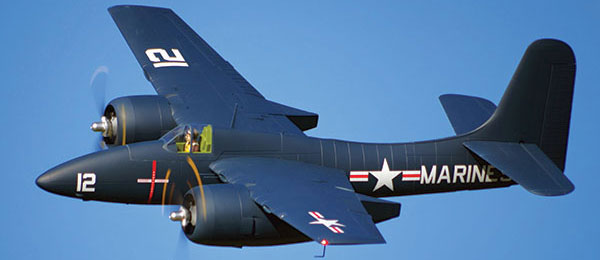
Written by Jon Barnes Fly the Navy's first twin-engine fighter Product review As seen in the February 2017 issue of Model Aviation.
Bonus video
Specifications
Model type: Twin electric warbird Skill level: Intermediate Wingspan: 63 inches Wing area: 670 square inches Length: 55.1 inches Weight: 124 ounces Power system: Twin brushless electric Radio: Minimum six channels required Construction: EPO foam Street price: $349Test-model details
Motors used: Two 3748-600 Kv brushless outrunners Speed controllers: Two 60-amp brushless with 5-amp BEC; T-connector Battery: Two Admiral 4S 14.8-volt 40C 4,000 mAh or two Admiral 4S 35C 3,000 mAh LiPos Propellers: 12 x 7 three-blade Radio system: Spektrum DX9 Stealth transmitter; Spektrum AR8000 receiver Ready-to-fly weight: 149 ounces using two Admiral 4S 4,000 mAh LiPos Flight duration: 6 to 8 minutesPluses
• First mass-produced, electric-powered, foam-composition model of the F7F-3 Tigercat. • Officially licensed by Northrop Grumman Corporation. • Ball-link-style connections used on all control surfaces. • Large-diameter tires encourage operations from grass airstrips. • Smooth and stable in-flight performance qualifies this model as an excellent first twin. • Optional scale extras include aluminum suspension struts and radio antenna.Minuses
• Some of the propeller graphics spun off within a flight or two. • The tongue of the battery hatch must be trimmed when using the recommended 4,000 mAh battery packs.Product review
There is no mistaking the uniquely harmonious symphony produced by a pair of multibladed propellers tearing through the air at thousands of rpm. Although warbird enthusiasts have always had an abundance of single-engine warbird models from which to choose, twin-engine warbirds have typically been a rare breed. FlightLineRC, a joint venture between Freewing and Motion RC that was established early in 2016, exploded onto the scene with the release of a 1,600mm wingspan twin electric-powered P-38 Lightning. This large, feature-rich twin set a new standard for what pilots could expect in an EPO-foam-constructed, electric-powered, multiengine warbird. After its big P-38, FlightLineRC released a pilot-pleasing medley of enticing and exciting single-engine warbirds. These included a pair of seldom-modeled aircraft, as well as two popular and perennial favorite warbird models. Warbird and twin enthusiasts alike should be excited with the announcement and release of the 1,600mm, twin electric-powered F7F-3 Tigercat! This Plug-N-Play kit, officially licensed by Northrop Grumman Corporation, stands out as the first mass-produced EPO-foam-composite Tigercat. A 1,600mm wingspan qualifies this model as a 1/10-scale rendition.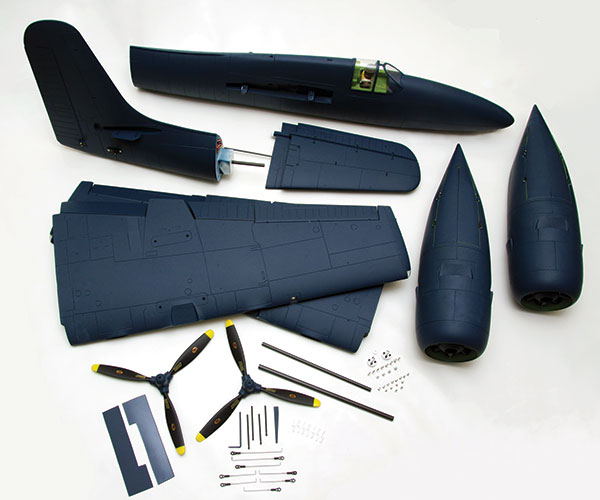
Although it is a relatively large Plug-N-Play kit, the F7F-3 features a surprisingly low parts count and is assembled using adhesive (included) and fasteners.
The previously mentioned FlightLineRC P-38 is also a 1/10-scale model and utilizes the same brushless power system as the P-38. A pilot already vested in the P-38 could use the same 4S 3,000 mAh LiPo batteries. Motion RC lists the range of acceptable battery capacities for the F7F-3 as four-cell 3,000 to 4,000 mAh battery packs.
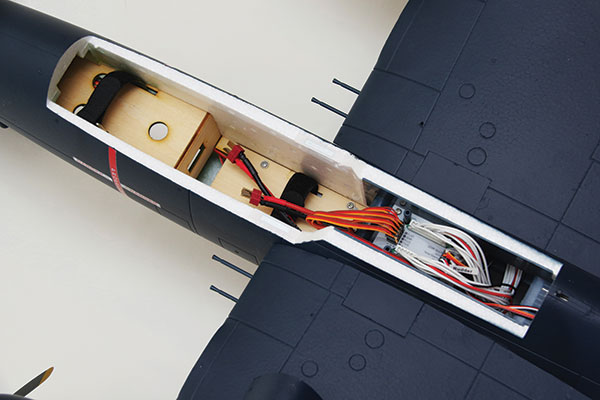
The Tigercat requires two four-cell 3,000 to 4,000 mAh LiPo batteries. They are placed in the narrow fuselage in a unique, end-to-end, high/low configuration.
A quick walk-around of the model reveals inboard/outboard split flaps, electric retractable tricycle gear, full gear doors on all three retracts, a pair of 12 x 7 three-blade propellers, and a painted pilot bust. The EPO foam used to construct this model arrives painted in a scalelike, military matte blue-gray color. The insides of the gear wells are painted a zinc-chromate shade of green. The model’s gear doors are not servo driven. Long springs are connected between the two gear doors and stretched across the gear bay openings. The gear struts contact these springs as they retract, effectively pulling the gear doors closed behind the gear as they pull upward into the engine nacelles and fuselage. Large-diameter tires hint at the feasibility of operating this model from grass runways. Ball-link connectors are used on the control surface ends of all of the pushrods. FlightLineRC includes several sheets of double-backed vinyl graphics that allow pilots to finish a Tigercat in one of several military-based schemes.
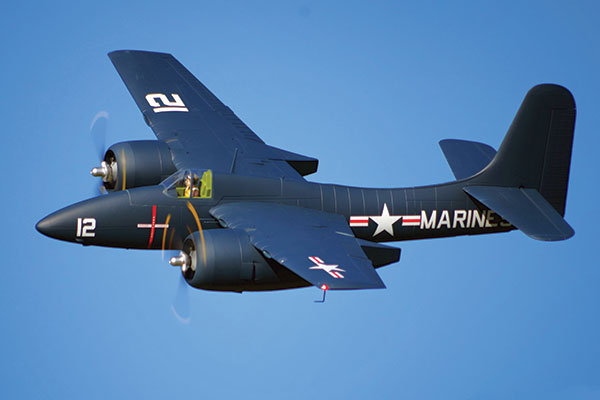
Standout scalelike features include three-blade propellers, navigation and landing lights, and the freedom to choose between multiple included military graphics schemes.
Construction
Assembly of this big twin is unique in that pilots must glue the aft section of the fuselage to the main fuselage; a long carbon-fiber rod helps to structurally unite the two parts. Epoxy is the adhesive of choice when attaching these two pieces. The method I use involves a bamboo skewer to poke an abundance of small holes in the mating surfaces before applying the adhesive. This method creates a stronger bond and helps to prevent any excess epoxy from oozing out of the joint and potentially messing up the matte-finish blue paint used on this model. The balance of the airframe components are assembled using fasteners. This includes the two large-diameter engine nacelles, the two wing halves, and the horizontal stabilizer/elevator assemblies. The plastic antenna, gun barrels, and underwing Pitot tube are designed to fit snugly into the provided holes. No adhesives are required or even recommended. This allows pilots to easily remove them for replacement or when transporting the large model. Each wing assembly includes a pair of flap servos, an aileron servo, an electric retract, and either one or two lights. The servo, lighting, and retract wiring is routed toward the wing roots via deep channels molded into the underside of the wing halves. All of the wing wiring plugs into a row of header pins, which are nicely labeled and located near the wing roots. After the wires have all been neatly tucked in place in the wiring troughs, blue plastic covers are tacked in place using contact-style adhesive. When attaching the wings to the fuselage, one removable, multipin cable is used to route all of the wiring in each wing half into the fuselage. Both wing cables plug into a white printed circuit board (PCB) module that is mounted in the fuselage at the aft end of the cockpit hatch opening. This PCB outputs the ultimate connection points to the receiver in the form of standard male-to-male servo extensions. Aggregating all of the wing wiring into one connector for each wing half greatly simplifies and expedites the removal and attachment of the wings. The only wing wires not included in these multipin cables are the speed-controller-to-battery connections. These two cables come factory wired with T connectors and must be independently routed into the forward part of the fuselage to connect to the batteries. When removing the long, narrow canopy hatch that is held in place with a pair of magnets and a spring-loaded release pin at the rear, the best practice is to grasp it near the middle. Grabbing it at the aft end and lifting upward against the strong magnets can potentially stress and permanently crinkle the foam hatch. The battery bays are positioned longitudinally in the narrow fuselage and staggered in a high/low configuration. Hook-and-loop retention straps are preinstalled. Although the full-scale Tigercat did not use counter-rotating propellers, this model is designed to be flown with the propellers configured as such. Pilots should set up the motor rotations so that the bottom of the propellers rotate outward and away from one another. FlightLineRC includes oval-shaped propeller logos and root stencils with this kit. They nicely enhance the appearance of the scalelike three-blade propellers, although several of them detached on the maiden flight. The gray and black plastic radial engine mock-ups, mounted inside of the engine nacelles, similarly enhance the scalelike appearance of this model and look quite realistic. Pilots can choose from several historically accurate military graphics schemes. These included graphics are printed on quality, double-backed vinyl and look fantastic when applied to the matte-finish blue paint.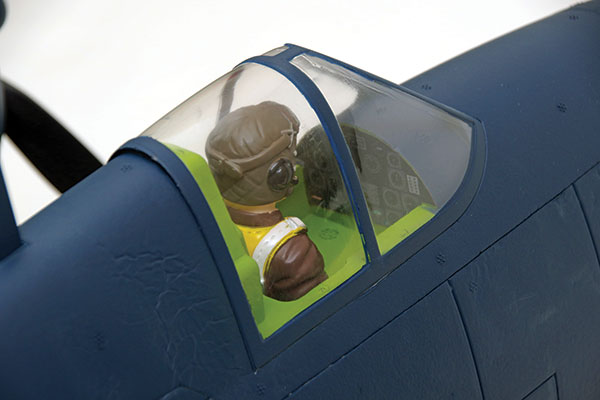
The cockpit and gear well interiors are all painted in a scale-enhancing, zinc-chromate-hued green.
Those who are interested in adding an onboard sound system will love the cavernous interior dimensions of the main gear wheel wells. They offer the perfect location to mount the speakers.
Flying
Getting a pair of flight batteries anchored in place can be challenging, given the narrow dimensions of the Tigercat’s fuselage. When using the recommended Admiral 4S 4,000 mAh LiPos, the removable canopy hatch’s indexing tongue did not quite fit into the area above the forward battery. It was necessary to trim some material from the underside of this tongue. Pilots who use dimensionally smaller battery packs will probably not need to make this small modification. Although many might be accustomed to disconnecting the red wire from one speed controller when configuring a twin-engine electric model, it is unnecessary in this case. The BECs used in the two speed controllers are designed to capably coexist. Most tricycle gear-equipped models offer the advantage of better ground handling and tracking. The F7F-3 Tigercat is no exception. This big twin tracks superbly when taking off and during the landing rollout. Corrective rudder inputs were seldom required during either. Pilots who fly from grass fields will be pleased by the relatively large-diameter tires used on this model. The mains measure 3.25 inches, while the nose gear comes in at 2.75 inches. Another plus is that the 12 x 7 three-blade propellers have more than 2 inches of ground clearance. The long, steeply raked nose gear closely resembles that used on the full-scale airplane and gives this model an aggressive-looking, nose-high stance.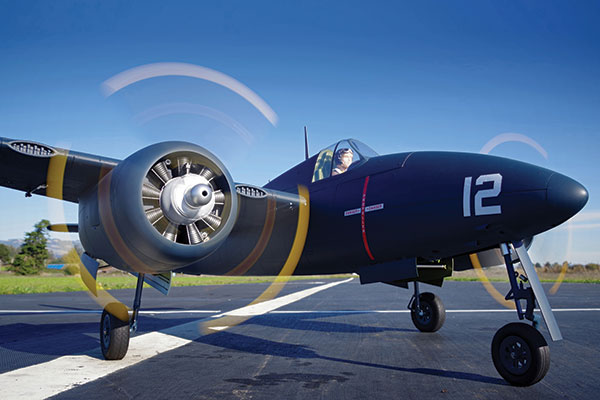
This warbird twin includes plastic, dummy radial engines and closely mimics the full-scale Tigercat’s trademark long, steeply raked nose gear.
With the flaps in the takeoff position and the throttles slowly eased forward, the Tigercat will smoothly accelerate down the runway, easily hold to the centerline, and lift off in a scalelike, shallow angle-of-attack departure. Equally scalelike landings are easy to perform and look best when using full flaps. The slow-speed performance and stability of this big Tigercat, when in the landing pattern, is sure to build the confidence of pilots who are new to twins. Pilots might, however, find themselves experiencing a brief moment of panic when deploying the landing gear. There is a 3- to 4-second delay from the moment when a pilot flips the gear switch until the tricycle gear actually emerges from the engine nacelles and fuselage and drops into position. The white landing light, located in the wing’s leading edge, is configured to automatically switch on whenever the gear is down. This light is bright enough to be visible on even the sunniest of days, as are the wingtip-mounted, flashing, red and green navigation lights. With the gear stowed and the flaps up, the Tigercat is in its element. At full rpm, each power system is good for roughly 575 watts. When fully unleashed, the aircraft has 125 watts per pound of performance on tap. Full-throttle passes on the deck showcase how fantastic this twin looks, sounds, and performs. The sound of a twin passing by at speed is sensational! This model’s somewhat atypically large, vertical stabilizer helps to keep the Tigercat laterally locked in, and the small amount of dihedral present in the wing offers impressive in-flight stability.
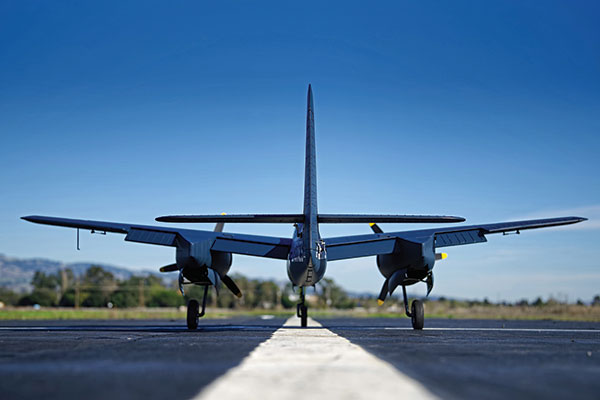
The dihedral-equipped wing and oversize vertical stabilizer combine to give this foam model impressive in-flight tracking and stability.
Warbird-style aerobatics are certainly within this model’s repertoire and include large loops, aileron rolls, and hammerheads. The Tigercat likes a little rudder added in during turns to help keep the tail in line. When flown on the recommended 4S 4,000 mAh battery packs, flight durations can range anywhere from 4 to 8 minutes. This Tigercat can also be flown on 4S 3,000 mAh packs, but expect to shave a couple of minutes off of the flight time. Conclusion Although the release of the FlightLine 1,600mm P-38 had many twin-loving pilots beside themselves with excitement, the surprise release of this similar-size and similarly powered F7F-3 Tigercat will assuredly have many warbird enthusiasts eager to purchase it. The price point of this seldom-modeled twin is hard to beat. Those who have felt the temptation to try a twin will find this foam Tigercat’s impressively stable in-flight performance worthy of consideration. As is always the case, FlightLineRC stocks a full selection of spare parts. Optional extras offered for this model include a set of suspension-equipped struts and the scale wire antenna that runs up to the tip of the vertical stabilizer. Those fixated on squeezing every bit of speed and performance from the Tigercat will be able to purchase a higher-performance power system that uses two-blade propellers. FlightLineRC again delivers! —Jon Barnes [email protected]










Add new comment